#vanitas no carte meta
Text
VnC timeline
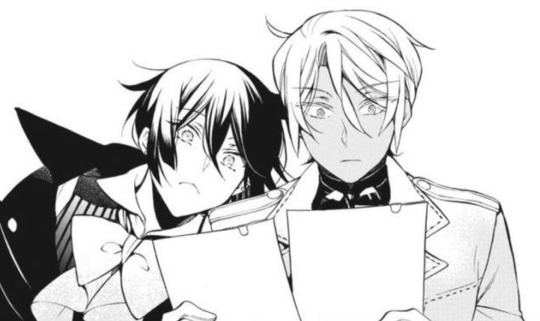
I’m mostly an artist in this fandom, but sometimes inspiration strikes and leads me in completely weird directions, such as… figuring out dates of every event in VnC!
With the invaluable help of @retracexcviii, who has created timelines for VnC events before (thank you forever and ever💜) and helped me to avoid some really silly mistakes, I’ve done… this monstrosity of a text, which includes every important canon event I could think of.
— All events are distributed by centuries, starting with XVI and finishing with XIX, and after listing all the events of each century I will put screens of the same texts with correlating manga pages. Additionally, there are numbers of chapters for most of the events.
— Some dates are marked with ~, which means that this date could fluctuate a bit (could be a bit earlier or later).
— Events that I couldn’t put anywhere specifically are in “UNKNOWN MOMENT” category. I still tried to differentiate them between centuries.
Alright, here we go!
XVI CENTURY
1493-1500 — creation of an engraving; plague, cataclysms, Paracelsius is looking for a way to save humanity.
(7)
~ 1500 — Babel. The awakening of Faustina, who is considered to be the first vampire.
(19)
1500-1550 — the awakening of Teacher and Machina as vampires. Machina might be younger than Teacher. Creation (awakening?) of Luna? The awakening of Teacher and the creation of Luna — probably around the same time?
(19)
~ 1550-1560 — Chloe is born. She becomes a vampire at the age of 4.
(31)
Between 1550-1600 — Ruthven becomes a vampire. He is currently more that 200 years old, and it’s unknown whether he was born as a vampire or awaken or even when exactly his life began. But looks like an adult in 1650, so he was most likely alive in 1600. He is also younger than Chloe: when she calls him a “child”, he doesn’t correct her.
(31)
Presumable order of awakening of the oldest vampires:
Faustina —> Teacher —> Machina —> Chloe —> Ruthven.
When exactly was Luna born? Does Kresnik exist in this century?
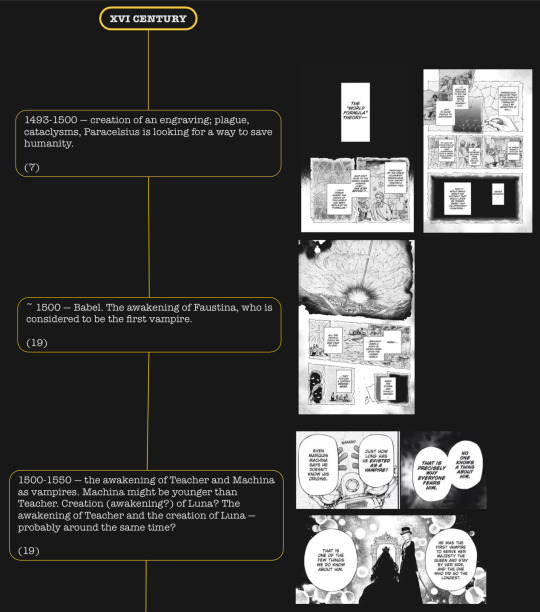
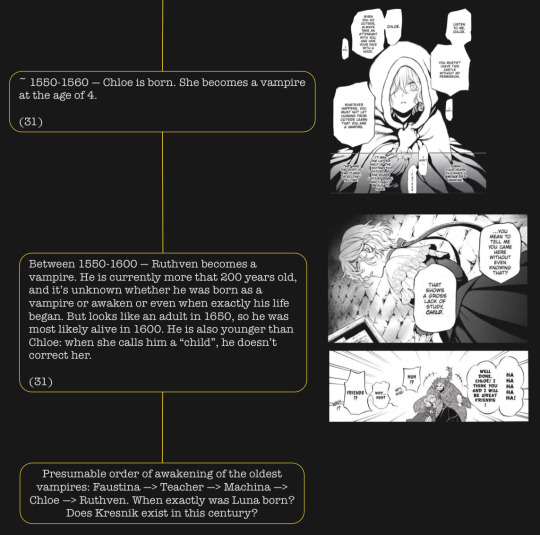
XVII CENTURY
~ 1650 — the war between humans and vampires. Chloe meets Ruthven.
(31)
~ 1665-1669 — Jeanne awakens in a flask in front of an unknown person. She leaves the flask. Later, she is adopted by Eric and Louise, Ruthven's students.
(39)
~ 1669 — Chloe meets Jeanne. Ruthven tries to establish peace between humans and vampires.
(31, 32)
~ 1672 — (3 years after Chloe and Jeanne met, 30 years before the end of the war) Ruthven loses his students, his eye is injured; Jeanne becomes the Bourreau of the Senate; Chloe meets Machina; Machina tells about the fate of Ruthven and Jeanne. Almost immediately, Naenia appears for the first time (indicating that Faustina is already a cursebearer); Ruthven visits Chloe for the last time, they part as enemies. If Naenia exists, does Charlatan exist as well?
(32, 33)
UNKNOWN MOMENT BEFORE 1672 — Faustina becomes a cursebearer.
(33)
UNKNOWN MOMENT BEFORE 1672 — Luna creates the Books of Vanitas, which are considered to be the reason for the appearance of the Malnomen. Could the books be created to cure the cursebearers in the first place? Most likely, this happened early in the timeline, since there is a whole folklore about it. Even earlier, someone gave Luna the name " Vanitas", which is also reflected in the title of the books.
(48, 49)


XVIII CENTURY
Before 1702 — Ruthven joins the Oriflamme family, becomes one of the Queen's advisors and a senator. The Queen is still alive, but she is also active as Naenia. Luna sees Jeanne in battle.
(33)
1702 — the end of the war. According to the pact, vampires move to Altus and sell Astermite to humans in exchange for other goods.
(33, 59)
1764 — Chloe spends more than 50 years alone. Death of village girl Jeanne, who speculated to be killed by a Beast, but was a victim of radical anti-vampire group. On the same day, she is visited by Naenia and then meets Jean-Jacques. The Beast conspiracy continues.
(36, 33)
1767 — Chloe witnesses one of the murders and reveals her vampiric powers when she defends herself. After that, the general belief is that Chloe is the master of the mysterious nonexistent Beast and both are the culprits. Her human family is killed. A few days later the Chasseurs (Vampire eradication fraction?) and Ruthven come to Gévaudan. Jean-Jacques becomes a Cursebearer to protect Chloe. Jeanne, now the Hellfire Witch, finds Chloe. Chloe tries to jump off a cliff, but Naenia comes to her again. Chloe also becomes the Cursebearer. Jeanne kills other hunters, but Ruthven saves her, makes her give him an oath (she tries to resist) and puts her in deep sleep. The Beast stops attacks. Conspiracy between Ruthven and the Chasseurs presumably continues.
(35, 36, 37, 43, 39)
UNKNOWN MOMENT BETWEEN 1672-1702 — Luna witnesses Jeanne in a fight with vampires. Later, after 1767, Luna also knew about Jeanne’s sleep.
(4)
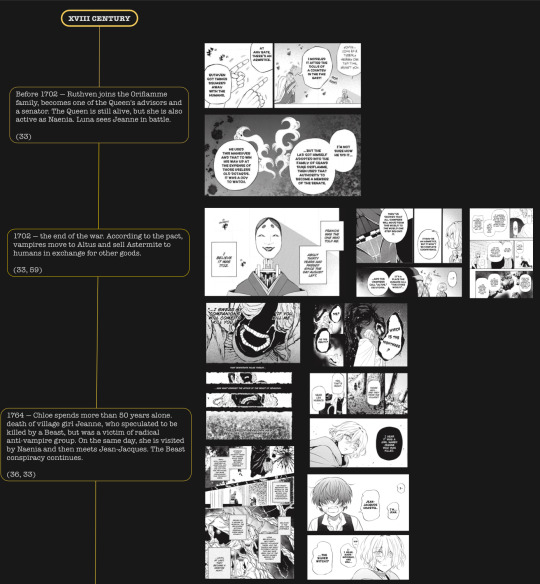

XIX CENTURY
1861 — Olivier is born.
1862 — Roland is born.
1868 — Dominique and Louis are born. Teacher takes Louis.
(46)
1869 — Noé is born.
1870 — Vanitas is born; Dante is born.
1873 — Astolfo is born.
~ 1875 — Olivier meets Roland.
(58)
~ 1874-1875 — an elderly couple finds Noé. They live together for some time.
(9)
~ 1876 — Mikhail is born. Luca is probably born around the same time or a bit later.
~ 1876-1877 — Noé is kidnapped and ends up in a black market, gets an eye injury and is bought by Teacher. Noé meets Domi and Louis (their proportions are quite similar to Astolfo in his childhood flashbacks, where he is presumed to be around 8 years old, but Noé looks younger, so here I’m assuming Noé and the twins could be 6-7 or 7-8 years old). // Probably around the same time, Dante is abandoned by unknown woman. He meets Johann and Riche. Absence of his glasses and bandages indicate that there could be at least a few weeks or months between the two events.
(9, 61, 62)
~ before 1881 — Vanitas is orphaned and placed under the care of the Church as a potential future Chasseur, but is kidnapped by Moreau for secret experiments.
(49)
1881 — sketch of the Tower of the Sun by Amédée Sébillot, electrical engineer. He worked with engineer Jules Bourdais on this project, but in fact the tower was unrealizable. If the monument designed by Sébillot was real, it would have collapsed under its own weight.
Before or early 1881 — Roland and Olivier move to Paris. Roland is injured, but it’s unknown how it happened. Olivier’s hairstyle may indicate that it happened earlier than the time when Roland almost died.
(46.5)
~ 1881 — Roland (vice-captain) is injured while defending Olivier. Olivier was injured too. // Misha (who looks about 5 years old??) meets Roland, but later ends up in Moreau's laboratory, where Vanitas is already located.
(47)
~ 1881-1882 — Astolfo secretly meets a vampire. When Astolfo befriends Olivier, he tells him about this secret. The death of the Granatum family. Astolfo meets Carl, Roland (his injuries, which were still visible when he met Misha, have already healed) and other Paladins. Olivier definitely had a title of Obsidian by the time of Granatums’ murder, so some time passes between the day Astolfo met a vampire and the day of Granatums’ murder.
(48, 58)
~ 1882-1883 1881-1882* — Louis dies. Domi learns the truth about her and Louis being twins. // Luna saves Misha and Vanitas when they destroy Moreau's lab*. Moreau joins the Charlatan. Misha agrees to be bitten by Luna. Later, Luna loses their true name; Misha loses their arm; Luna dies by Vanitas’s hands. Vanitas and Misha inherit the Books, but are separated, and Teacher takes Misha.
*@torterrachampion mentioned in reblog that Noé is officially 12 years old when Louis’s died ang provided an image from a booklet for the Blu-ray of the anime. I completely missed that fact, so thank you for bringing it up! I’ve decided to change the time range for this event to 1881-1882 for better accuracy.
*It is likely that Noé witnessed Louis’s death around the same time Vanitas and Misha were saved by Luna; bonus card features Noé in the same outfit as on the day of Louis’s death together with Vanitas dressed in his lab clothes. 1881 or 1882 is a possible year for Louis’s death and salvation of Vanitas and Misha. In this scenario Luna dies later than Louis.
(9, 46, 51, * bonus card)
1887 — possible start of construction of the Tower of the Sun (in reality, the construction of the Eiffel Tower started on 28 January 1887).
~ 1887-1888 — Astolfo and Roland have a conflict.
(59)
UNKNOWN MOMENT (after 1702?) BEFORE 1888 — Veronica and Loki, along with Machina, become Beastias, and Antoine enters the Senate. How old are Veronica, Antione and Loki?
UNKNOWN MOMENT (not earlier than 12 years?*) BEFORE 1888 — “death” of Faustina at the hands of her Beasts and Rusven. Luka replaces her on the throne, but the Senate controls him. Strangely, he isn’t even officially presented yet. It’s unknown how old he was when he assumed his current position, but it’s unlikely that the Senate and Beastias would “kill” the Queen without choosing a suitable successor first.
*Alternatively, it could happen earlier, if Loki, Luca’s older brother, was supposed to inherit the throne prior to becoming a cursebearer as well, but was replaced with Luca. But this is a pure speculation.
(38, 13)
UNKNOWN MOMENT BEFORE 1874 — Archivists disappear. It’s unknown whether there are any living Archivists other than Machina and Noé in the present. It’s also unknown why Noe thinks about blood when he thinks about his clan.
(57)
UNKNOWN MOMENT BETWEEN 1871-1888 — Vanitas meets Teacher, or Saint—Germain, who at that time had a different appearance. Were Luna alive at that moment?
(55)
UNKNOWN MOMENT BEFORE 1888 — Machina becomes patron of the dhampires and creates her network of information brokers.
(62)
~ 1888 (before current events) — Astolfo and Roland become Paladins. // 6 month before — Teacher goes somewhere. // 1 month before — Jeanne awakens from her sleep.
(13, 4)
1888 — Teacher asks Noé to witness the story of the Book of Vanitas via correspondence. Current events begin.
(1, 52)
Possible future event — The Exposition Universelle of 1889, which was held in Paris, 5 May to 31 October. The Tower of Sun (instead of Eiffel Tower in VnC universe) was created for this fair. However, at least some of the buildings were ruined.
(44, 20.5, 46, 55)
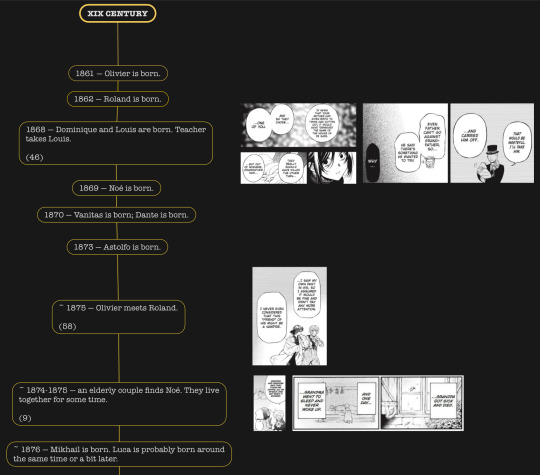
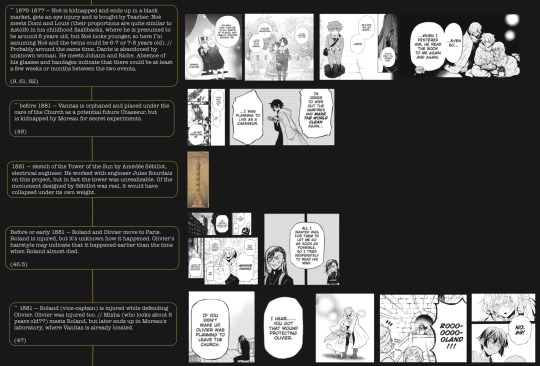
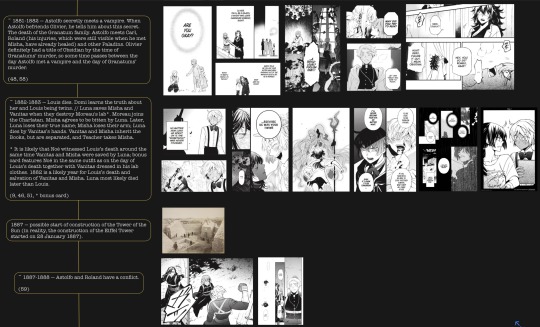
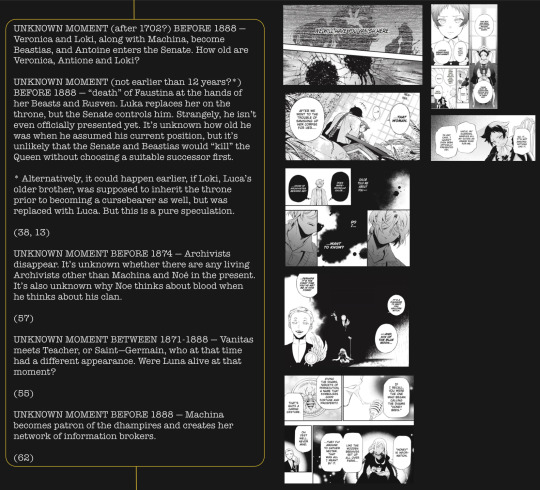
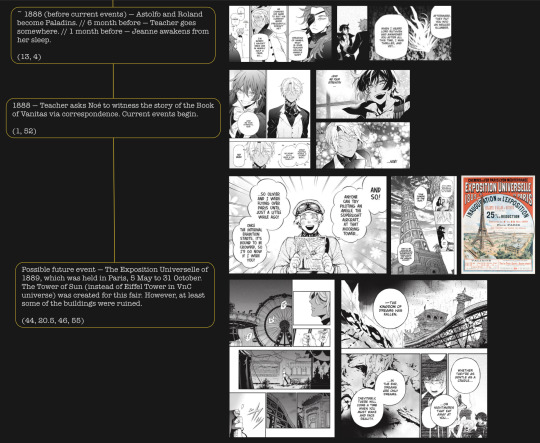
That’s it for now!
I think I will update this post in future when we have enough new information to define unclear dates and add new details and whatnot~
#vanitas no carte#the case study of vanitas#memoir of vanitas#vanitas no shuki#vnc meta#vnc theorie#mochizuki jun#mochijunverse#vanitas no carte meta#vanitas no carte timeline#vnc timeline#not official#vnc spoilers#vnc#vnc noe#vnc vanitas#vnc dominique#vnc jeanne#vnc teacher#vnc ruthven#vnc chloe#vnc naenia#vnc chasseurs#vnc louis#vnc beastias#vnc luna#idk if I should use name tags here honestly but this is related to them?? whatever let it be
296 notes
·
View notes
Text
I think one of the reasons I'm absolutely insane about Jun Mochizuki's work is because she's the only person I've seen do a perfect execution of the "abused becomes the abuser" trope.
All of the characters in Pandora Heart and Vanitas no Carte are incredibly morally complex. They're heart wrenching, relatable, endearing, aggravating, and endlessly flawed.
MochiJun puts us in the uncomfortable position of confronting that victims can be perpetrators, that those who are hurt can hurt others, that sometimes, people you love are bad, and sometimes you love bad people.
Abuse is never justified; it's handled by different characters in a variety of ways. It's repressed, reciprocated, passed on, and stopped. MochiJun shows victims become awful people, not inherently because they were abused, but because of who they are as people and how that shapes the way they deal with abuse.
She shows victims as the complex people they are beyond victimhood. There are characters who are just and kind after facing abuse, and ones who are twisted and cruel. Most delightfully, she brings us characters who are both.
The heroes of her stories choose love, gentleness, compassion, and mercy. She shows that our choices matter, that our relationships are integral to who we are.
I think of how some of the characters, in spite of these forgiving traits, are not required to forgive their abusers in order to be seen as virtuous figures. They're allowed to stand their ground, even if it's violent to do so.
I think of how, at the same time, some characters are loved despite being abusive, because a tender character sees more in them than evil. Because abuse comes from people, and people are endlessly complex.
I think of how the heroes of the story tear themselves apart for the violence they inflict, and are shown the most painful love in return. How that love often comes in the form of calling them out on their bullshit.
I love the love in Pandora Hearts and in Vanitas no Carte because it's painfully human in the face of horrors beyond mortal comprehension.
I love the flaws in the characters because they're painfully human despite some of these characters' otherworldly natures.
Jun Mochizuki doesn't show us the abused becoming abusers to give us the idea that abuse is an unstoppable cycle, but rather to show that it is stoppable. To show that people have a choice in who they become. And that's one of the most wonderful and terrible things about people.
#alkafdjklfjklfdjfk i'm so normal about mochijun's work i promise#pandora hearts#vanitas no carte#vnc#the case study of vanitas#jun mochizuki#meta#analysis
433 notes
·
View notes
Text
Not the Vanitas vol. 11 cover equaling Noé's desire for tarte Tatin locked behind the mirror, unable to touch it, for his desire for Vanitas.
(EDIT: SPECIAL VARIANT COVER! NOT OFFICIAL COVER!)
Bc Vanitas is the center of the cover, focus et all. It's the homemade by Vani Tarte Tatin and how it symbolizes their budding relationship and feelings. Vanitas serious face incongruous with Noé stars in his eyes. His clothes which aren't the typical he wears but his secondary/emergency ones, which we saw on that chapter he and Dominique commiserate about their feelings for Noé and the clothes thing is very heavily linked to identity and specifically a sense of security for Vani.
Holy shit. Vani is not dressing as Vanitas for this cover. He's not smirking or putting a front. He's holding up that Tarte Tatin as himself.
I'm gonna start clawing, climbing my walls. Mochijun!!!!??
The sandtimer earring is completely insignificant when usually is super prominent for Vani artwork! It's there but you miss it on first sight.
Murr is also behind the window/mirror with Noé! SUS! IT'S SO SUS!
Am I paranoid or just suitably scared of Mochijun ability to foreshadow? Who knows. Not me for sure.
I'm still reeling about how obvious this cover makes Noé attachment to Vanitas and viceversa. Come on! The way we all know those stars in the eyes are for the Tarte Tatin, but also Vanitas blood and the relationship Noé has/wants with him.
Mochijun!!!!!!!
96 notes
·
View notes
Text
There is one thing I'd like to discuss.

I really don't like this panel. It's drawn to provide effect like Astolfo and unnamed vampire boy are equal. Like vampire boy was an innocent victim. But was he really?
First of all, vampire boy doesn't say: "Your dad killed my parents". He says "Paladin". It could be Gano, Ogier or even Olivier. But most likely not Astolfo's father (in that case I think it would be told). So vampire boy attacked innocent people that are not connected to his parents death. He attacked even children who helped him and saved him. It was not revenge because he didn't find his parents killer. Instead he found a defenseless prey.


Second: vampire boy and his adult friends get pleasure from torturing weak innocent children that can't protect themselves. Days by days. It's a very specific kind of personality. Torturing requires cold head and planning and getting pleasure from someone's suffering. It's not like some feature of character that everyone can have. It's a trait of maniac.
Third: were vampire boy and his parents really innocent victims of chasseurs rampage? Let's see what Vanitas says, when Roland asks is Noe really a vampire:

Vanitas isn't interested in justification of chasseurs actions so his words must reflect the real state of affairs. Usually chasseurs hunt real criminals. Why did they hunt vampire boy family? It's very hard to find some innocent vampire family that lives quietly in human world. They looks like average humans - like Noe who works in human café and nobody suspect him as a vampire. And it's much more easy to find vampires that attack humans: they have a trail of blood and corpses behind them.
In summary: I really don't think vampire boy and his family was innocent. Innocent vampires usually are not chasseurs target. Innocent people don't attack someone who helped them and don't like tortures. And don't have friends that can torture six years old child to death.
#vanitas no carte#vanitas no shuki#unnamed vampire boy#astolfo granatum#fandom meta#manga#by mochizuki jun#tw: canon typical violence#tw: mention of death#tw: mention of tortures
29 notes
·
View notes
Text
Knowledge in VNC : About Noé's eyes
So, we all remember that when Noé was very, very young he was injuried in one of his eye right ?
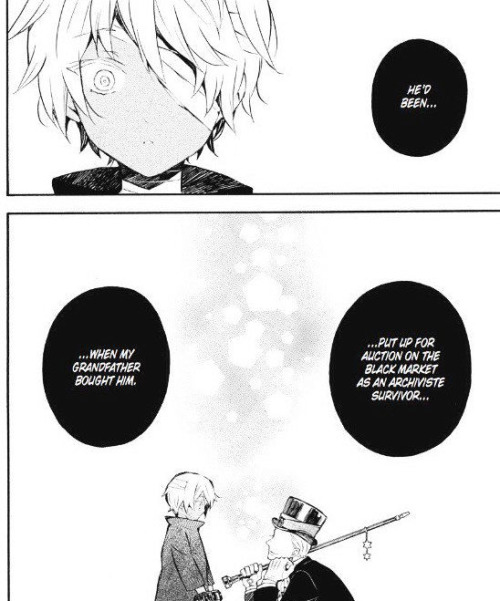
While people wonder why his left eye specifically, I might have the answer to this.
In latin, left is said "sinister" but in french it gave the word "sinistre" which means omnious and therefore lead to countless surpestition of left briging you infortune, on why you should never eat with your left hand, or that the wrong decision is always to choose the thing in the left etc. This comes from the Greek since Roman saw the left/sinister as a sign of good fortune and since VNC is full of latin/french reference it might be why.
Anyway, that answered. I'd like to point out something. In the Opening 1 of VNC, 空と虚/The sky and the void, towards the end of the 1st chorus, those lines are mentionned :
その目に僕は見えるでしょう?But those eyes can see me, can’t they?
You migh wonder why there would be such a focus on vision. Well, for a long, long time vision is associated with knowdlege which is why the word "blind" can have the literal meaning of not seeing things and the figurative meaning of not seeing them in the sense that you are ignorant about it despite the answer being right under your nose.
So to explain this I'd like to use two mythological reference : Oedipus and Tiresias.
Oedipus is know very infamous for giving it's name to something Freud called Oedipus complex, but in Sophocleus's tragedy, Oedipus king, there is an interesting play between the vision and the knowledge thanks to the use of the verb σκοπέω/skopeo which both means to see/to observes and to judge/to think. Hence the play shows us an Oedipus that has the answer to the question he has at the begining reguarding Laios's murderer and the fact that his wife Jocaste is actually his biological mother, but he doesn't see it, he is figuratively blind which causes him to not see in the sense of him making terrible decision and when he finally begin to see the truth, he is crushed by reality which causes him to blind himself literaly, saying that he is now as blind as he used to be at the beginging of the play. I could go on with this due to how interesting this auto mutilation act is, however I am supposed to focus on VNC.
Following this logic, I think that Noé's "bad eyesight" is mainly symbolic to how he is blind to some things of the world. At the begining of the story, he is mainly a child at heart, an innocent and well intentioned young man. He is pretty much a white page, he doesn't know the reality of so many thing and concept such as love or salvation. His vision is cracked to shows how much of an unreliable narrator he can be. We already had many instance of Noé's vision on an event being portrayed differently. See when he met Vani for the first time :


VS in chapter 52


We may wonder why it changed right ? well, it's because Noé vision/perception of things is shaped by what he knows of it.
An example of this in the Ball masqué arc
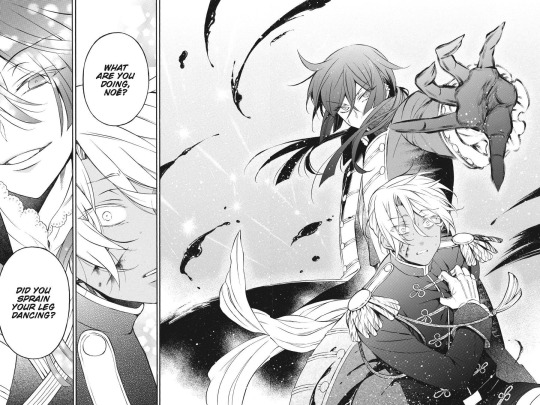
That's how Noé sees Vanitas. He is portrayed as radiant here, and the reason isn't just because he saved him from Naenia, but because Noé saw Vanitas saving several vampires using the Reverse operation, which gives him hope.
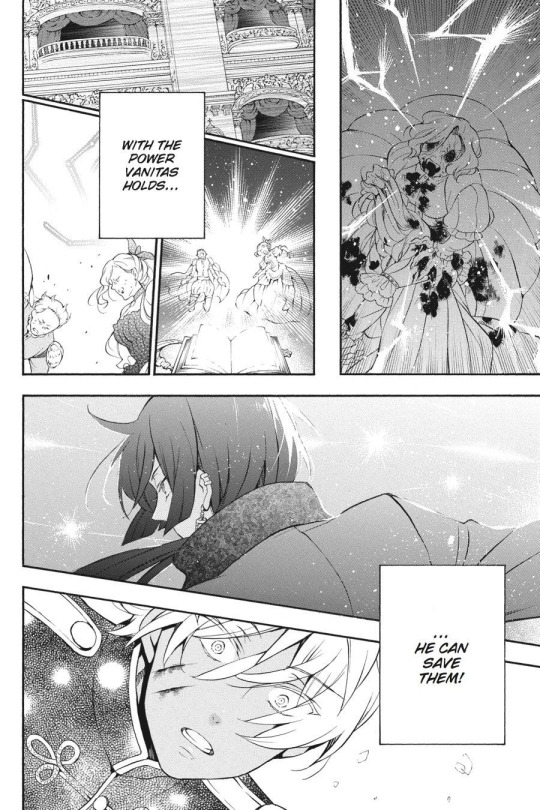
Vanitas is seen as a saving figure because it restored Noé's hope. After all, he experienced the loss of his childhood friend due to Curse bearer degeneration and this happen right after Naenia made him remember that.
However, when Vanitas fails to save Catherine and kills her instead, the portrayal/way Noé's view him changes
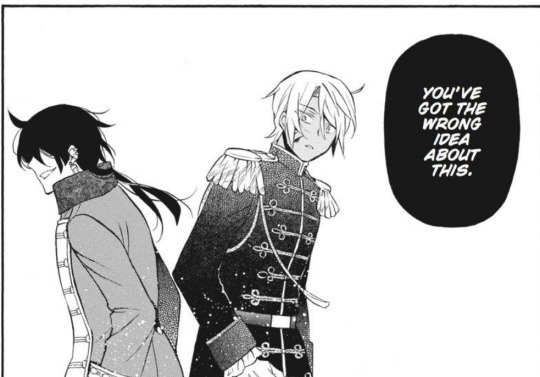
Vanitas's dialogue is in a dark bubble leading to understand the dialogue has a dark connotation which worries Noé creating a transition
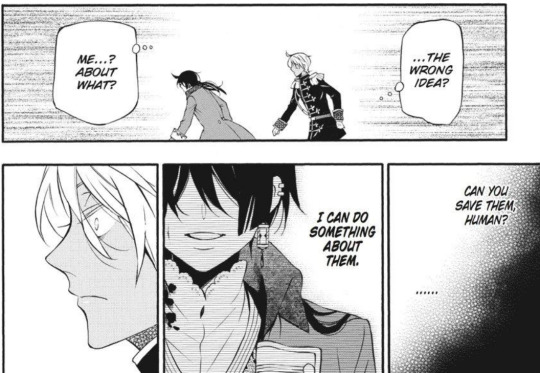
The panel where darkness seems to be growing and thus contrast with the light panel where Vani's hair shines brighter with the use of trame; replaced now by ink to signify darnkess as taken over, and here it's in Noé's vision.
When we are at the point where he will kill Catherine, Noé becomes more hesistant, the look on the panel showing his anxiety and then

He remembered the face Vani made when he claimed to save all the Vampires but with the dialogue he said a bit earlier, and while many commented on how threatning this face is, the fact that Noé remember this face right as Vanitas is about to kill Catherine says a lot on how he ended up viewing him very differently from the moment Vanitas saved him.


With this example, you can see that Noé's perception is limited to what he knows of the thing he see, modeling how he sees things.
By the time of chapter 52, Vanitas could have once again appears in his soft side, having saved Chloé and having Noé learn about his own insecurities. But in this chapter, Vanitas threaten to kill his childhood, friend, hence he doesn't view him anymore as the same and is unable to focus on him. An blatant example is how he failed to notice that Vanitas made this face when he tried to attack him.
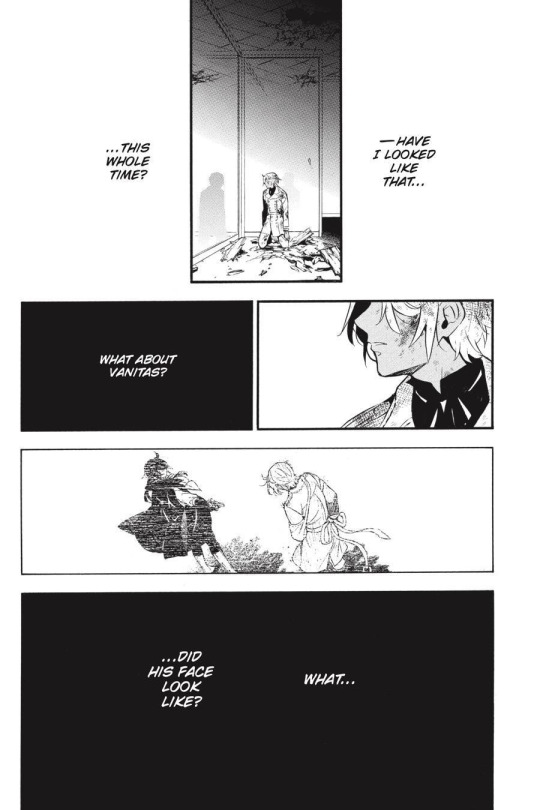
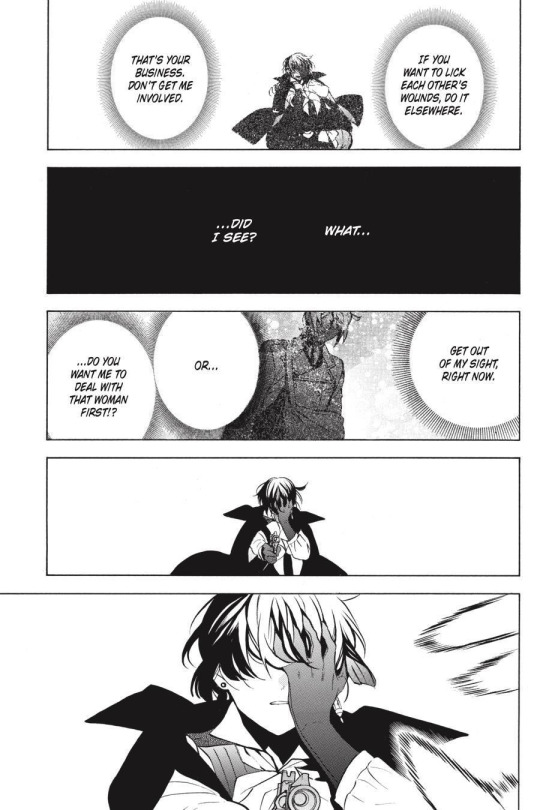
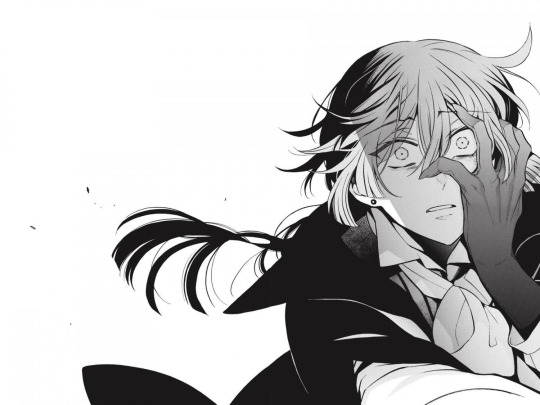
He will admits it himself, but it isn't before Jeanne, an objective watcher call hims out

That he snaps out. And even then he doesn't understand

Until he sees himself in the mirror

The fact that Noé's vision of Vanitas is shaped by what Vanitas let him see of him, coupled by his blind self makes him an unreliable narrator, especially when it comes to what VNC is about : knowing who Vanitas is.
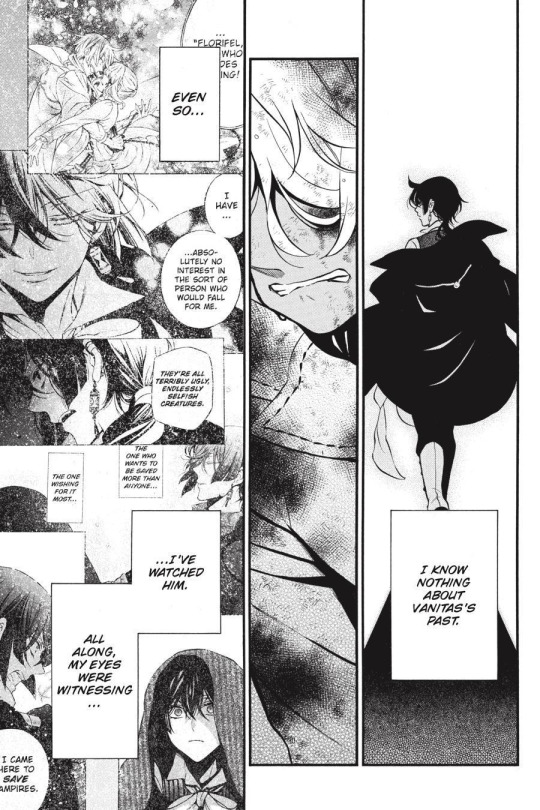
Hence, I think Noé's eyesight is actually refering to this element, that he is figuratively blind. At least for now.
But it should also be noted that Noé and Vanitas don't view the same thing in the same way as they have different knowledge of it and I think nothing illustrates it better then their duet song, Le Formidable where the chorus goes as such :
I walk into this
useless (Vanitas)
wonderous (Noé)
world
The chorus and some of the verse are constantly showing the dichotomy of how these two sees the world, contrasting between Noé optimism view and Vanitas's pessimistiv view, and the two untertwining creates a sense of discontinuity within the lyrics as the song keeps switching between their 2 POV which is complete polar opposite and this is more notable when the song comes to the chorus where both voices finally sings together and seems to have finally meet, but to show that while they live in the same world and lives the same adventures, they don't view things in the same way.
Now talking about Tirésias. He was a mythic poet that was cursed with blindness but the gods granted him in compensation the gift to see the future and he became a famous fortune teller. This is actually linked to an old, old belief about blindness. That although they can't see, the are gifted with a knowledge unabling them to see what is invisible to the common man. And while blind people often have sharpended sense, this is also linked to the old belief that the poet as prophetic talents.
So how does it link with Noé ?
Noé is actually an entity that is double : with have past Noé, the character and present Noé, the narrator/writer of the story. Past Noé is blind, but present Noé, while a potentially unreliable narrator is the one that knows how the story ends. After all, the end of chapter 1 sounds like a premonition.

And that's because it already happen. Like for Oedipus that couldn't escape his fate, the story Noé is telling is bound to end like that because it's what the narrator already experienced. There is that critic Jean Paul Sartre made about true stories not existing arguing that the moment you tell a story when you know the ending of it, it cease be authentic because we don't know how things are supposed to end. And indeed, no one but God can know what will happen in the future. It is what is name the occult, ot "what is hidden"... what people used to believe blind people could see as compensation for their defective eyesight.
That add up to the fact Noé was shown to be literaly defective within his eyesight due to his injury. But canonically Noé has the power to know something that others vampire in particular can't. As an Archiviste, he can knows the past of someone by drinking their blood and looking into their memories, which got him to have a lot of people looking down on him for that has it's allowing him to look on what is intimate, etymologitically, what is deep inside of them, that which they occult. And in the case of Vanitas in particular, it's something that 1/ Vanitas don't want him to know 2/Noé admits in chapter 52 to not know.
However, as I mentionned the narrator knows the ending of the story, which contrast with how Noé is ignorant of the events of VNC compared to his future self narrating the story. And in chapter 56, there is finally a hint of him learning his irremediable fate
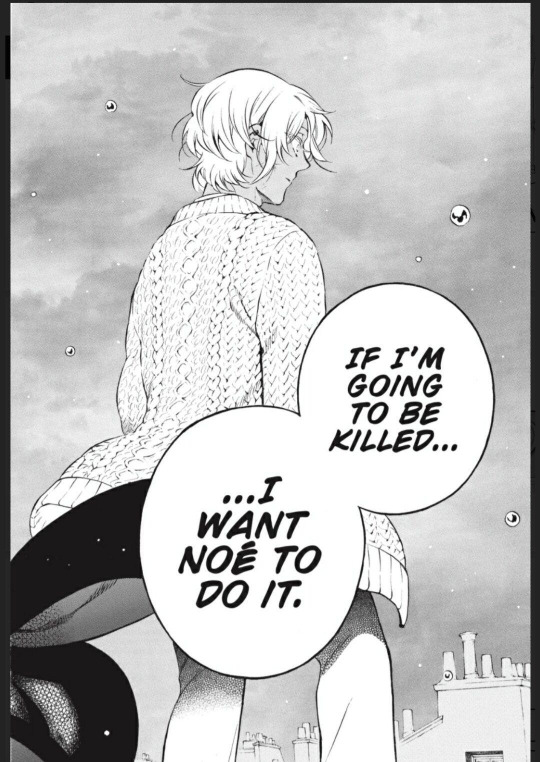
From the mouth of Vanitas, Noé learns what is future self already knew and told the audience.
This might be an indicator that Noé will manage to pass of his initial blindess as he tells the story and thus recover a proper eyesight, signifying be able to see things other then through a veil of ignorance/innocence/subjectivity.
And this can be seen as through VNC, there are clear instance of Vanitas moments focused when Noé was simply not here, and thus should not know about it, specially when Vanitas nevers tell him about it, such as his meeting with Jeanne at the ball, his discussion with her during the lunch Lucas invited them to partake, their meeting at the ball, their date in Paris or in the cabine.
There is also the fact that he relates his meeting with Ruthven in the meantime, when he should have forgotten about it. Or, the most obvious piece of evidence, the fact that he was able to convey how Vanitas felt when he attacked him even though the chapter made it clear Noé had no idea on how he looked like

This for instance, shows that Noé/narrator was able to overcome his own biais and overcome the fact he would have remained an unreliable narrator had his vision not changed.
Long story short is that Noé/narrator knows and see what Noé/character doesn't know/see and shows us the ignorance he had at the time, while keeping in mind that Noé/character doesn't know while Noé/narrator is the one who knows everything. What is going to happen, how it is going to unfold.
Thus it is very important to remember that what Noé/character sees will constantly be challenged by what his future self saw and therefore knows.
And considering that VNC heavily deals with how Noé's vision of the world is constantly challenged throughout the story, I think it is possible that his character would evolve in such a way
#vanitas no carte#the case study of vanitas#vanitas no shuki#jun mochizuki#noé archiviste#meta analysis#manga analysis#greek mythology
104 notes
·
View notes
Note
in the last ep of the anime, i noticed that it cut out to the ending directly before vanitas could actually take noes hand, and i wondered if that was referencing what noe said about vanitas at the beginning.
Oh that's such a good catch! You're absolutely right anon, and I think we can take your idea even further than that.
I've talked about this in a previous post, but VnC's running refrain of Noé reaching for Vanitas's hand is really symbolic. Noé has saved Vanitas from literally falling multiple times, but their entire relationship is also one big metaphorical outstretched hand. Vanitas is "falling" down toward his inevitable doom as he self destructs via his revenge, and Noé is grasping out desperately as he tries to catch him and save him from that fate.
"That day when I didn't grab your hand" (which I assume, along with killing him, is what you mean by "what Noé said about Vanitas") might refer to a future event in which Noé will literally fail to catch Vanitas. But more importantly, it's a reference to the larger truth. By Noé's definition of salvation—in terms of preventing his death, Noé is going to fail to save Vanitas. No amount of reaching out can prevent his ultimate fall.
Within this metaphor, then, the scene on the rooftop after the amusement park can be summed up simply. It's the scene where Vanitas finally lets himself reach for Noé's offered hand.
I mean this in three ways.
The first way is the literal way. The scene ends with Vanitas reaching up to take Noé's hand and be helped to his feet. And despite the sheer frequency of Noé reaching out for or trying to catch Vanitas, this is only the second time we see Vanitas actually reach up and take Noé's hand to be helped of his own accord. The only other time is in the catacombs, right before he decides to tell Noé about Doctor Moreau for the first time.
In the catacombs, Vanitas taking Noé's hand works as a symbolic gesture of trust and an acceptance of Noé's help with the Moreau case. Noé has been forcing his help on Vanitas up until this point, staying up late by the door just to follow him out, but taking his hand is the moment that Vani starts to willingly bring him into the fold. The literal is never just literal with these guys.
The second way comes when Vanitas tells Noé that he's "given up on making him do what he wants." As I said, Noé has spent the entire manga reaching out and trying to save Vanitas from his "fall." One major facet of that is his recurring refusal to let Vanitas isolate himself. He makes a willful declaration of staying by his side when Vanitas tries to dismiss him in the bell tower, and when Vanitas tries to cut Noé out of his life by the blade of a knife, Noé comes back with "I will never set you free." Vanitas wants, or at least claims he wants, Noé to leave him the hell alone, but Noé says no every time.
"Giving up on making Noé do what he wants," then, means that Vanitas has finally let himself accept that he wants Noé by his side. There's no more pretending he doesn't want his help or his presence. No more trying to shove Noé away every time he's upset. At least in this moment (though we'll have to see if he holds himself to it), Vanitas has admitted that he wants Noé and Noé's supportiveness in his life.
Mochijun even uses a flashback panel to be sure we know exactly what Vanitas means here. It's that important.

Giving up on trying to push Noé away is one very significant way in which Vanitas has accepted the metaphorical outstretched hand. He's admitting he wants Noé, and Noé's presence means the presence of love and help. It means the end of self-isolation as a maladaptive coping technique. Of course he's going to reach up and accept Noé's literal offer to help him to his feet in the same scene that he finally tells Noé he'll stop trying to get rid of him.
The third way is, of course, when Vanitas says that he wants Noé to be the one to kill him.
Now, this is not how Noé wanted Vanitas to interpret his outstretched hand. Unlike his loved ones, Noé does not see killing and being killed as a way to show love or to save someone. His offer of salvation is meant to be an offer to save Vanitas from his self-destruction. But Vanitas does not want to be saved that way. And given that the manga begins with the statement that Noé will kill him someday, we know that Vanitas cannot be saved by Noé's definition.
However, Vanitas does not share Noé's definition of salvation. I don't know if Vanitas himself could even put words to his personal idea of salvation. But we know from multiple examples that it can sometimes include the gift of a kind death to prevent a worse life. That's the kind of salvation he offers when he returns a curse bearer's True Name despite knowing that it will kill them.
I have a lot of thoughts about the kind of salvation Vanitas could find in Noé, but for the purposes of this scene, this idea of a preferable death is a big one. Vanitas would rather die than lose his humanity, and this is an extremely vulnerable thing for him. Saying that he wants Noé to kill him is, in his own way, accepting Noé's unspoken offer of salvation. He's saying "I want you to be the one to save me in the one way that I can accept."
Vanitas cannot envision a life for himself, and thanks to the way Luna's Mark is rewriting him, it's likely that a long life as his human self would be impossible even if he weren't suicidal. But though it's still not healthy behavior, his request for death is, in his own terms, taking up the hand that Noé has extended. It's a grasp for salvation by a man that cannot admit that he wants to be saved.
And that brings me back to your original point, anon. Because Vanitas reaches up for Noé's hand, and that is incredibly important, but in both the anime and the manga, we do not get to see him take it. The meaning of this depends on what definition of salvation you analyze the scene through.
By Noé's definition, we know that Vanitas cannot and will not be saved. As he says in the beginning, Noé is going to kill him someday. There will be a day when he will fail to grab his hand, and Vanitas will finally fall to the gravity of his doom. So in that way, it makes sense that even in the most optimistic of scenes, we have to cut away before Vanitas can actually take Noé's hand. He might be letting himself reach for it now, and that's a good thing, but Noé is never actually going to be able to pull him up. To show us otherwise in a scene so full of symbolism and foreshadowing would be a lie.
However, as I keep saying, Noé's definition of salvation isn't the only one at play. As much as Vanitas's death will not be prevented, the fact remains that he is still finally letting himself reach for salvation in some form. So perhaps we can cut away as soon as he starts to reach not because he'll never be saved, but because the thing that matters in this scene is the reaching itself. Noé has become a supportive constant in Vanitas's life. He's just reaffirmed that he won't change, that he'll continue to support Vanitas from beside him.
We don't need to see Noé take Vanitas's hand once he starts reaching because that is a foregone conclusion. It's Vanitas's decision to reach that needs the emphasis of being the final shot, because that's the heart of the moment.
In the manga, Vanitas reaches up, and we cut to the sunlit sky. This whole scene, in addition to the running thread of reaching hands and salvation, has an overarching symbol in the end of the rain. Vanitas and Noé's horrible fight was in the storm, the rain patters to its end as they make up, and the sun breaks through the clouds as they reaffirm their pledges to one another and Noé re-offers Vanitas his hand. It's simple but effective pathetic fallacy.
So to that end, Vanitas reaches up to take Noé's offer to help him stand (reaches up to take some version of his promise of salvation), and we cut to the sunlit sky. Noé has brought the sunlight back as he offers his hand to Vanitas. Joy and light and hope return as Noé's love for and desire to save Vanitas are reestablished. Then Vanitas reaches toward that light, and we cut to the sunbeams to make sure you know just what he's reaching toward.
This works well for the end of a story arc! The weather symbol has been a constant throughout the whole amusement park arc, so of course the chapter that marks its end has to be capped off with an image of the clouds breaking. It's a closing note that pulls together Vanitas's reaching for salvation, the weather symbolism, and 55.5's general tone of relief.
Meanwhile, the anime switches things so that we see the sunbeams first, and then Vanitas reaching for Noé's hand is the final shot of the whole entire show. And for once, I actually really like this little change! The manga's order of images works well as a resolution for its chapter and its story arc, but the anime's version works really well as a possible end for the story overall.
The VnC anime may or may not ever get another season, so for the foreseeable future, Vanitas reaching for Noé's hand is the end of the show. This gives that shot a lot of emphasis. In fact, it kind of makes it the meaning of the whole thing.
Noé spends the whole anime reaching out and trying to offer a hand of salvation to Vanitas, and the final shot of the whole thing is Vanitas letting himself reach up to take it. We don't end on the shot of their clasping hands, but the shot of the reaching, because Vanitas's decision to accept some form of salvation is the thing the whole show has been building towards. It's the decision to reach up that makes the whole story.
So though they go about it in very slightly different ways, the manga and the anime are still both making meaning out of the simple act of Vanitas reaching. That's the core of the whole thing.
And overall, though I've framed "we cut away because Noé won't actually be able to stop his fall/grab his hand" and "we cut away because the decision to reach is the important part" as two opposing interpretations, I actually think their co-existence is key. Vnc's whole story is a conflict between Noé and Vanitas's definitions of salvation. The tension of their relationship isn't "will Noé find a way to save Vanitas from death?" (He won't). The tension is "will Noé find some other way to save Vanitas before his death?" and "will he be able to recognize that alternate salvation as salvation if/once Vanitas claims it?"
VnC is a story about a doomed man who might in some way be saved. Chapter 55.5 cuts away before we see Vanitas actually take Noé's hand because he is doomed to fall someday and not reach that hand when it matters most, but also because the thing that matters in this scene is that he decides to reach up at all. Vanitas is going to die, so any hope and optimism in his story must make peace with the doom of him. His healing from his trauma and accepting love and help happens while he is hurtling rapidly toward his ending. That's the beauty and the tension of Vanoé's relationship (and the beauty and tension of VnC as a whole).
So to answer your question anon, yes. We cut away before Vanitas reaches Noé's hand because, as we're told in the beginning, he will not ultimately reach Noé's salvation. But at the same time, the whole point of the rooftop scene is that Vanitas does want to accept some kind of salvation, and he just might manage do it. It all depends on how he can be saved.
#This uh. this might be my longest ever post#anon you really lit my brain on fire with this ask (complimentary)#I don't think I've ever broken 2k words in one post before#sometimes running this blog feels like I am assembling one giant patchwork quilt of meta that will someday come#to span and link together the entire series#this post is one of those times#it feels like anon just pointed me in the direction of a key spot to add a section of quilting to#that I had somehow never quite noticed by myself before#but looking at it now. it's incredibly obvious how this piece was always going to be part of the patchwork#good god I love this series#vnc#vanitas no carte#the case study of vanitas#vanitas#noé archiviste#vanitas vnc#vnc 55.5#vanoé#vanoé tag#vanitas my beloved#ID in alt text#ask#anon
136 notes
·
View notes
Text
Wow. Being Dominique de Sade must suck. (VnC Meta)
Because imagine: you’re a vampire of a wealthy family, but you’re also a young woman in the Victorian era.
You’re also the pariah of your family as your older sister hates your guts, your older brother doesn’t care about you, and you’re being compared to your sister a lot by your parents.
The only company you have is your beloved other older brother, a kid your grandfather brought in, and some country kids. But, when trying to save one of those country kids from her fate goes awry, your beloved older brother goes berserk while protecting both you and your friend, then gets his head cut off.
Then following THAT, your older sister (who hates you btw) reveals that your brother and you were actually twins, causing you to have an identity crisis, survivor’s guilt, AND PTSD to boot.
And so, you combat this by deciding to wear boy’s clothes and be a bi badass with a sword, swoop ladies by their feet, and overall be the best character.
But then you get mind controlled by a little boy with white hair and it causes your childhood buddy and his human boyfriend to fight while you have to watch that go down (while mind controlled). But luckily, you (& the pretty pink haired boroeu girl you once danced with) save yourself from that mind control. So yeah.
Being Dominique de Sade must suck, but it’s also pretty cool and badass all at the same time.

#case study of vanitas#the case study of vanitas#les memoires de vanitas#vanitas no carte#vnc meta#dominique de sade#veronica de sade#louis de sade#antoine de sade#noé archiviste#jeanne the hellfire witch#domijeanne#dominoé#mikhail
133 notes
·
View notes
Text
The lost name

I think Vanitas’s real name could be Deucalion.
In this text I’ll cover my reasons for choosing this name, its connection to the story of Noah and the myth of Pandora and how would it correlate with the relationship of Vanitas and Noé.
Posting this as an actual answer to @scar-eyejolteon14 as promised here.
The lore of Deucalion
It all started when I was wondering what kind of name I could give Vani if I were to draw him as a Chasseur (ordinary human, who’ve never met Luna and never inherited their name). I began with the most obvious thing: checking Vani’s wiki page for existing details and references. I went with his zodiak sign, Aquarius, as the staring point, because stars and celestial bodies are recurring theme in VnC and well why not?..
The next obvious place to go is wiki page for Aquarius. Here we come across a fun thing: Babylonian star catalogues. They contained lists of stars, constellations, and planets.
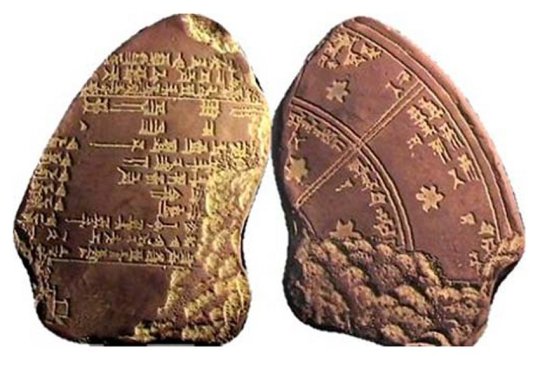

I found the first picture on a somewhat strange website, but whatever. This is a fragment of a circular star calendar, which belonged to the library of King Ashurbanipal (668-627 BC) in Nineveh. The second picture is a star list, found in Uruk (320-150 BC). It had information on all constellations such as names, number of stars, their distance, etc. Just so we understand that astronomy was a big deal there.
And yes, the capital of Babylonia was Babel — that one city with the tower (The Book of Genesis, Genesis 11) which is referenced in VnC.

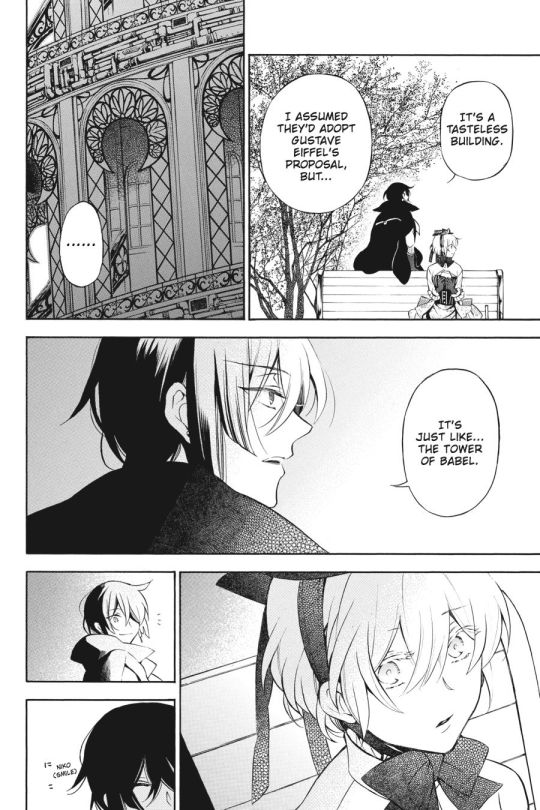
(Ch. 21)
What did Babylonian astronomers think of Aquarius? Well, they associated this constellation with the Ea. “The Great One” is his title. He’s also known as Enki, god of magic, fertility, creation, etc., who was originally a water god (and his temple name E-apsu means “house of the watery deep", idk I think it sounds really cool). The water theme is not random: Aquarius was also associated with floods. Water was sacred, but also deadly: floods were source of destruction.

Later, a Latin author Gaius Julius Hyginus quoted an Alexandrian historian Hegesianax that Deucalion is to be identified with Aquarius, "because during his reign such quantities of water poured from the sky that the great Flood resulted." Again, we see the idea of destructive flood. But where does Deucalion bring us? To Noah. Or Noé, if you will.

(Ch. 1)
Deucalion and Noah
Both Deucalion and Noah are central figures of the classical flood myth, which exists in various cultures. While these two are probably among the most popular figures, there are other examples, including Utnapishtim, who was warned by the god Ea (who also created humans among other things) about the flood and instructs him to build a boat and save his family and animals. The stories of Deucalion and Noah follow the same pattern with some minor variations. But Deucalion is the one who is associated with Aquarius, the constellation that symbolizes the coming of the flood and all its terrors, while Noah/Noé is associated with salvation of human race and all living things.

Deluge, 1864, by Aivazovsky. This painting depicts a beginning of a biblical story about the near-end of human race. It’s pretty much the same in other versions of the story.
Deucalion and Pandora
What’s interesting, Deucalion’s myth is directly related to Pandora’s myth. Deucalion is usually described as the son of Prometheus, while Deucalion’s wife Pyrrha was the daughter of Pandora. And Pandora’s myth is among the core themes of “Pandora hearts”. If we consider the possibility of VnC and PH’s universes being connected, the idea of Deucalion being Vani’s true name would also make sense… For example, this theory covers the topic.
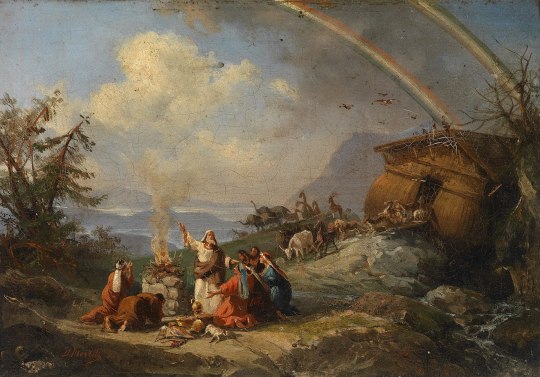

Left – Noah gives Thanks for Deliverance, 1901, by Domenico Morelli. Here we see Noah from the Old Testament, with his family, as they give thanks for their safe deliverance back to land after surviving the flood. A double rainbow signifies God’s presence.
Right – Deucalion and Pyrrha, 1636–1637, by Rubens. This painting shows a scene from the story of Deucalion and Pyrrha as told by Ovid in Metamorphoses. After surviving the disaster, they had to throw stones over their shoulders, each of which became a new human being.
Even if worlds of Pandora Hearts and Vanitas no Carte don’t exist in the same universe, there clearly is thematical relation between the two stories, one being about hope and another about despair. What’s even more interesting, there was actually a whole discourse about what’s hidden in Pandora’s jar: is it true hope or is it actually an illusion of salvation which hurts even more than actual despair? The translation of the word elpis, the spirit of hope in the jar, is actually neutral in its meaning. It’s simply “hope”, not inherently “good” or “bad”, which leaves a lot of space for interpretation in media.
Vanitas and Noé
Volume 3 cover implies that Vanitas will be marked by an Archiviste. It’s unknown whether this Archiviste would ne Noé or Machina or even some other. I hope it’s gonna be Noé, because it would break a specific border between them and it will definitely be very dramatic, but Machina might do it for the sake of obtaining information, which is her main thing. Anyway, regardless of who does this, when and why, I believe that this moment is probably the real possibility for revealing the true name of Vanitas.
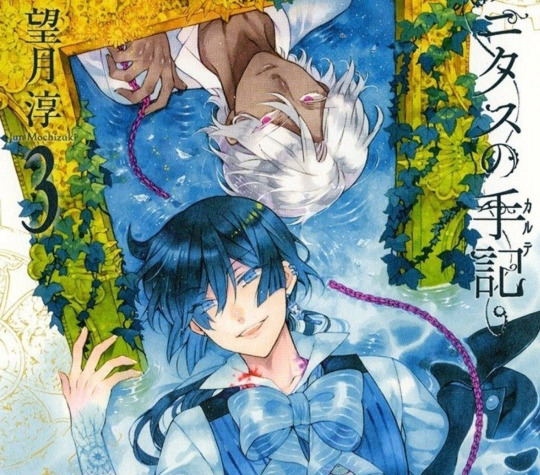
On a side note, it would also be kinda interesting if Noé gets to know Vani’s true name, but it will still be hidden from us, the readers. There’s is also a possibility that Vani’s true name will not be revealed even in this situation. His goal is to erase everything related to the Vampire of the Blue Moon, and I guess that would mean erasing everything about himself too. But in Ch1 he promises to stay here even after he is gone, so it might imply that at least someone will get to remember him — perhaps as Xxxx the human, not Vanitas, kin of the Blue Moon. Which might mean going against Luna’s request…

(Ch. 50)
And, well, Xxxx could de Deucalion. Just think about it: wouldn’t it be cool if both Vani and Noé were given names with similar symbolism behind it and later both assume the moniker of Vanitas?
Plus the whole “loop” thing, like “memory loop” theory and “time loop theory” (here and here) again adds to the idea of connection between them. The loop where ends and beginnings melt into each other, like Ouroboros eating its own tail. The loop between Vanitas and Noé, where they will have to understand pointlessness and hopefulness of life – and what does in mean to save and be saved.
The ultimate hope of survival becomes fleeting dream for all caught in this loop. But every dream is destined to end, as pointed by Saint Germain. And what will happen, when Vanitas and Noé will have to wake up from the dream of their own? What will prevail - death and futility of life or salvation and rebirth?

(Ch. 55)
#vanitas no carte#memoir of vanitas#the case study of vanitas#vnc meta#vnc theory#vnc vanitas#vnc noé#vnc#mochizuki jun#case study of vanitas#noe archiviste#mochijunverse#vanitas no carte meta#vanitas no carte theory
56 notes
·
View notes
Text
Gil, the narrator of Pandora Hearts, is the only character who didn't die at some point in the story.
Noé is the narrator of Vanitas no Carte, so I think he'll live as long as that's his role. I'm worried MochiJun will shift the role of the narrator so she can kill Noé at some point.
The story of VNC is presented to us as memoirs written by Noé that detail Vanitas's story in the time he knew him, up until he kills him. However, MochiJun likes her twists and turns in the plot, so I know that she is likely deceiving us to some extent. The question is, to what extent is she deceiving us?
Will the story end when Noé's memoirs end, or will someone else pick up the tale? Perhaps another Archiviste?
#noé archiviste#vanitas no carte#vnc#the case study of vanitas#gilbert nightray#pandora hearts#pandora hearts spoilers#theory#meta#analysis
47 notes
·
View notes
Text
(crack) theory: machina was in love with luna
reason: we all know something is going on with vanoé thats a given but... noe and machina are also paralells...
each are close with a de sade (domi and veronica)
both are (likely) archivistes (on that point wtf has machina seen in veronica's blood memories... why do they trust each other???)
(also domi and veronica have brothers that look like them... louis and antoine)
both seem to be past students of teacher (why else would she behave for him during their barrier talk?)
the name vanitas was passed from luna to the vani we know, and vnc is known for doing that shit with names on purpose
which begs the question WHY DID MACHINA WANT VANITAS INVOLVED IN GEVAUDAN???? girl, what do you know?
#vnc spoilers#vnc meta#vnc manga spoilers#noé archiviste#marqis machina#lady archiviste#vnc#vanitas no carte#the case study of vanitas
36 notes
·
View notes
Text
Btw in tCSoV the way Louis explained things to Noé and how Vanitas does now is such an interesting contrast?
It's both of them looking at Noé naivety and good will with endearment,
but Vanitas recognizing Noé needs to know how the world works for him to thrive and not be taken advantage of and explaining to him what is what without sugarcoating but with gentleness (for him that is, but it's striking how soft he comes across for Noé)
and Louis being a young teen in a sheltered lost in the woods castle, who probably doesn't see the point of shattering Noé's illusions when he himself is so unhappy with his knowledge of how the world works and they won't ever be free of Grandfather/Master for Noé to need to know better.
I see what your doing MochiJun.
#my thoughts#the case study of vanitas#vanitas no carte#vnc meta#meta#noé archiviste#vnc vanitas#vnc noé#louis de sade#vnc louis#it's not shippy but it's not not shippy#I find it interesting that contrast#noé needs vanitas and viceversa#also I suspect noé ignorance was a balm to Louis as much as it hurt by the end#how this boy pretended to himself that Noé would be able to kill him?
35 notes
·
View notes
Text
vanitas from vnc is Roma-coded. rather, his family background indicates he, his father, and their caravan were stateless and nomadic. further, given the prevalence of Roma stereotypes in 19th century French literature, some of which compared Roma characters to vampires or vampire-like creatures, the then-role of the Church in defining French identity, and Vanitas's otherness from both vampires and humans, i don't think the coding is incidental.
i.e., while I'm also excited by the most recent chapter, I'm still thinking about how Vanitas explained systems of oppression and prejudice to Noé, how Vanitas deals closely with and understands the dhams, and how his ambiguity/simultaneous belonging and otherness are woven into his his very clothes.
further, Lady Archiviste had a close relationship with Luna based on her reaction when Shapeless One first appeared to her in Luna's skin. Noé also has always loved the Blue Moon and felt compelled by its beauty. I wonder if Archivistes, with their invasive and abhorred fangs, and the Vampire of the Blue Moon, with their invasive and abhorred grimoires, might have always been drawn to one another. and if Vanitas, even as a mere human, would resonate with that experience, finding far more comfort among the rejected and the demonized than any single community.
#vanitas no carte#vanitas no shuki#vnc#vanitas#okay no more vanitas meta those essays are for DMs and late night obsessing
35 notes
·
View notes
Text
VnC 58: the case study of astolfo
After a whole year of suspense, the Case Study of Vanitas is back with a bang and so is this tumblr blog. Time isn’t real, so let’s pretend that this analysis came out when I wrote it after reading chapter 58 rather than the day before chapter 59. Let’s go!
As always, although it’s been a while, this post will contain massive spoilers for VnC 58 and is intended for those who have read up to this point in the manga!
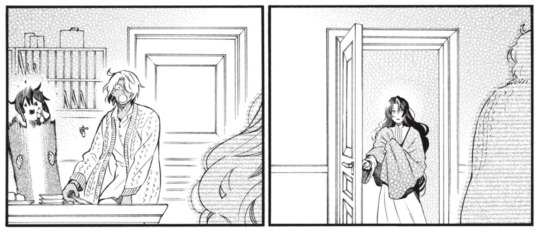
intergalactic tea party
Chapter 58 begins with (an absolutely stunning shot of Vanitas’s tarte tatin) a quick recap of the plot so far and where the main cast is at the moment— Domi and Jeanne tragically finish their conversation offscreen; Domi and Noé have an adorable reunion; and Jeanne leaves the hotel alone, likely to report on her successful mission to a worried Luca. Jeanne looks adorably carefree as she heads out and I pray for a flashback to her conversation with Domi in the near future.
Moving rapidly along, we cut to the Archiviste Noé caught a glimpse of last chapter, traveling through the border between worlds. We learn that she’s familiar with Comte and likely Luna as well, and she and Comte sit down to have a very Pandora Hearts flavored tea break. Comte says that mystery Archiviste hasn’t travelled to the human world in ages, making it very unlikely that she was there explicitly to see Noé, although it’s possible she was (like Comte) waiting in the shadows to intervene if the fair fight reached a certain point.
Mystarchiviste in turn reveals that Comte’s existence is “unstable”. The only context we really have for that term is Vani and Misha, artificial followers of the blue moon lying somewhere between human and vampire… Comte certainly acts like a vampire, but maybe he’s actually something much more in between? My half-theory half-headcanon is that his obsession with Luna stems partially from feeling commonality with another being who doesn’t understand their own existence…
Speaking of Luna, Comte taking their form has interesting lore implications (can he take the form of anyone he’s met, or is there another requirement that has to be met first?) and also interesting fanfic implications but let’s move rapidly onwards to the real meat of chapter 58.
the chasseurs are insane
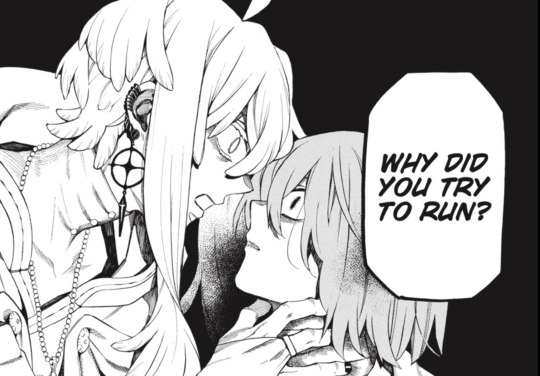
A majority of VnC 58 takes place in an extended flashback, as Astolfo reflects on his past. This flashback confirms a lot of what past chapters have implied about Astolfo— he was consumed by self hatred and guilt following the vampire attack, to the point of attempting suicide. The whole flashback could easily read as yet another parallel to Vanitas, who, after finding himself as the sole survivor a second time in a row, turned to a path he knew would culminate in his own death.
We meet two fun new characters during this section of the chapter— a guy wearing an earring (I was half-wondering if this was a younger version of Olivier’s assistant, but their eyebrows and earrings are different, so he’s probably one of Gano’s homeboys) and Charles.
Earring guy is suspicious. He might have some sort of plot relevant past (cough cough, No. 7- [i am escorted off the stage]), he might be an average chasseur with a vampire related incident in his history, or he might just be your standard issue psychopath. My favorite Mochijun Flavored Detail this chapter is the panel where, under the guise of breaking up Mira and Gano’s brawl, he moves to block Olivier’s line of sight and path to Astolfo. It’s just so Mochijun and i missed her so much—-
Charles is neato, but he sort of has this vibe where he’s not meant to be the star of the panels he’s in. It’s like Astolfo isn’t fully looking at him. Even though Charles is trying to inspire faith in Astolfo here, the only light Astolfo sees is Roland. In his double-page introductory panel Charles is exclusively lit by light coming in through the door as Roland opens it. Roland, meanwhile, looks like a savior, the light behind him blinding, and Astolfo bursts into tears when he sees him. I’m so excited to watch their relationship collapse as this flashback continues..!
Through Charles’s conversation with Astolfo, we learn a very interesting piece of lore: when a vampire bites someone they aren’t injecting an aphrodisiac or poison with their fangs— they’re actively rewriting their world formula, and sometimes these effects are permanent. I feel like I should’ve been able to riddle this out, given the whole mark of the blue moon thing, but the fact that this happens so frequently throughout the series, and that Jeanne has rewritten Vanitas, is feckin shocking and feels like it has some very interesting implications for the series. Perhaps Archivistes are unique in that, rather than rewriting with their bite, they read what’s already there.
I honestly don’t have many other thoughts on Charles. He gets carried around and nobody’s allowed see him, possibly implying that he’s become sicker/ his existence has gotten more unstable ;) since he originally became a paladin. Maybe he’s the head honcho Roland and Olivier are working against, maybe he’s actually dead by the time we hit the main plotline. At this point, it feels like he could move in any direction.
interpretation, extrapolation, being wrong, that’s the mochijuncycle

Vampires rewrite the world formula when they bite others, often leading to devastating and permanent consequences for those they’ve bitten. Misha and Vanitas aren’t the only two unstable beings in existence— while we’ve never heard of VnC vampires turning humans with their bite, maybe once a human has been rewritten enough times they too become unstable. Maybe Comte, in constantly changing his name and shape, has been rewriting himself to the point of instability. Maybe Noé struggles to rewrite because, as an Archiviste, he was born to simply read and record.
But you probably shouldn’t trust me on any of this because, as always, this is 100% my biased initial interpretation of Chapter 58! I hope you’re all as hyped to see this flashback play out as I am, and I’ll see you (hopefully somewhat) soon for VnC 59!
105 notes
·
View notes
Text
@idkwhatimdoingandyoucantstopme thank you for the interest to my post about vampire boy who betrayed Astolfo and sorry for such late response. I'm really happy my thoughts were interesting enough to make you write your answer. There are so many things I'd like to say because you've touched so many interesting themes. But today I'd like to stop only on one quote:
"Hell, roland almost even killed noe before he heard them out, and that was because of vanitas (a human)"
We usually love main characters when we read manga. We love Vanitas. We love Noe. And we consider characters that counter them as "evil". But is it true?
So my first question is: is Church really evil?
And answer is... uh, NO.
Church and chasseurs are one and only who protect mere humans. Like villagers of Saugues.
Vanitas doesn't save humans, he is curing cursed vampires.
Noe doesn't save humans, he helps Vanitas to cure cursed vampires.
Vampire government doesn't save humans, they are not interested in it.
Still, human traffic exists. Human slavery in vampire world exists - even Noe being a child became a victim of slave traders. Vampires like those who killed Astolfo's family exist. They do not vanish just because humans and vampires have official truce. There are always some percent of criminals even in an utopia world.
Average human can do totally nothing against average vampire. He or she is a helpless victim. And chasseurs are only one organization that helps average humans. So no, Church and chasseurs are totally not evil. If they vanish there will be no one to save humans. That's why chasseurs have license to kill vampire criminals. It's legal to kill for them. They are like police or army.
What about Gano and others extremists?
Yes, they are xenophobic and are evil. But they are not the hole Church.
What about Givaudan and Chloe?
First of all Church isn't one big hivemind. Those who began witch hunt and tried to kill Chloe are long dead. Like Noe can't be responsible for slave trader's crimes just because he is the same vampire nor Roland, nor Astolfo, nor even Gano can't be responsible for crimes some chasseurs did a hundred years ago.
Second - average chasseur doesn't know truth about Beast of Givaudan. Even paladins don't know truth because information is classified. Most likely Charles knows and it's his crime because he tries to kill an innocent to cover old dirty issues. But an average chasseur or even a paladin just thinks its an ordinary mission. They have human victims (5 women) and they try to save other people. That's all.
Ok, let's talk about vampires in catacombs. My second question is: did Noe and Vanitas had a right to invade catacombs?
And answer is... NO!!! Totally not!
Vampire society lives separately mostly in Altus. They have there own Queen and Senate - their own government. They have their own law. In fact they are a separate country.
Noe is a resident of "vampire French". And he secretly invaded a main army base of "human French" and get caught by it's army officer. Should I really explain how absurd it sounds "Roland should just listen the explanations"? No matter how good their intentions were from the point view of the law Noe and Vanitas committed a crime that could be even interpreted as an armed invasion and could become a reason to began a second human-vampire war. Even Roland understands that: that's why he asks Maria to lead Vanitas and Noe to the surface secretly.
From the point view of law it's ok to kill the intruder or to capture and interrogate him.
It's not ok to listen him and believe every his word and do as he says.
Resuming: that fact that Roland didn't listen to Noe and tried to kill him isn't a consequence of xenophobia. That are logical actions based on a law and a common sense. In fact it's far more strange to listen an armed intruder who invaded a war base of another country and do as he says.
--------------------------------------------------
As manga readers we know Noe and Vanitas had good intentions, tried to capture Moreau and save innocent vampires. But to be honest: what chance it was the vampire invaded catacombs turned out to be our kind Noe?
10 notes
·
View notes
Text

I KNEW there was gonna be something like this with those scissors
You cannot fucking trust Mochijun with scissors.
#also I’m in the middle of writing a long meta rn about astolfo#and how his obsessive focus on hating vampires is the only way he can cope w how much he blames himself for what happened to his fam#if he stops thinking about hating and wanting to kill vamps he’ll start thinking about hating and wanting to kill himself#and well.#this chapter sure doesn’t disagree w me#liveblog#vnc spoilers#vnc 58#ID in alt text#vanitas no carte#vnc#the case study of vanitas
115 notes
·
View notes
Text
The evolution of Vanitas' eyes, especially toward Noé:

This one comes from Jun Mochizuki's official twitter account, just a few days ago. We don't know what Vanitas is looking at (yes I zoomed in, theres no reflection that I can see), but I'm willing to bet it is Noé, and probably from a distance while Noé isn't looking at him.
I may very well be wrong, and that's okay. It still shows us how far Vanitas expressions have come.
From chapter 1, when he meets Noé, and many other times when he first introduces himself, there's hardly any life in those eyes:

That expression does change drastically at times, when he talks of his "vengence":

Everytime he talks about it, he's borderline mad. He also wears this same look with the first few curse bearers he treats. At this point he has three different main expressions: crazed, mocking, and soulless. From this panel alone I'm convinced half the reason Noé decided to stick with him was because he wanted to help him, actually help him as a person.
Here is chapter 10, when he saves Noé from getting his name stolen.

Gone is the crazed look. He's protective now. Angry at those who dare try to hurt Noé. Only chapter 10, and he's already like this!
In the same arc, when that dead-like expression resurfaces, Noé notices it, and stabs Vanitas right where it hurts. He understands him more and more with each day they spend together, and Vanitas' walls likewise drop, little by little.


Skipping all the way to chapter 40. This is his expression now when using his book of Vanitas for his vengence (or salvation, in Noé's words):

It's no longer about that, even. He goes into this knowing how much it will cost him, but he's not doing it for himself anymore. It's for Noé, for Jeanne, for Chloe. He's determined to see it through.
And of course, can't mention this arc without this tender scene.

The sheer intimacy of it. The affection in those eyes. Angled from Noé's POV, as Vanitas rubs his forehead. This is how Noé sees him 😭
And lastly, Noé's confession, when he tells Vanitas "I still don't like you or anything, but I'm glad you are the person you are now". Vanitas' eyes are welling up with TEARS, not from sadness, not from frustration or anger but being genuinely moved with his words. Noé says "I still don't like you" because he KNOWS Vanitas can't take anything else but those words yet. Vanitas likely knows this, and understands just how much Noé cares for him to consider him over his own feelings.

Excuse me while I cry over this. Have this last beautiful panel of Vanitas looking up at the source of his light, his salvation and happiness. Noé.

138 notes
·
View notes